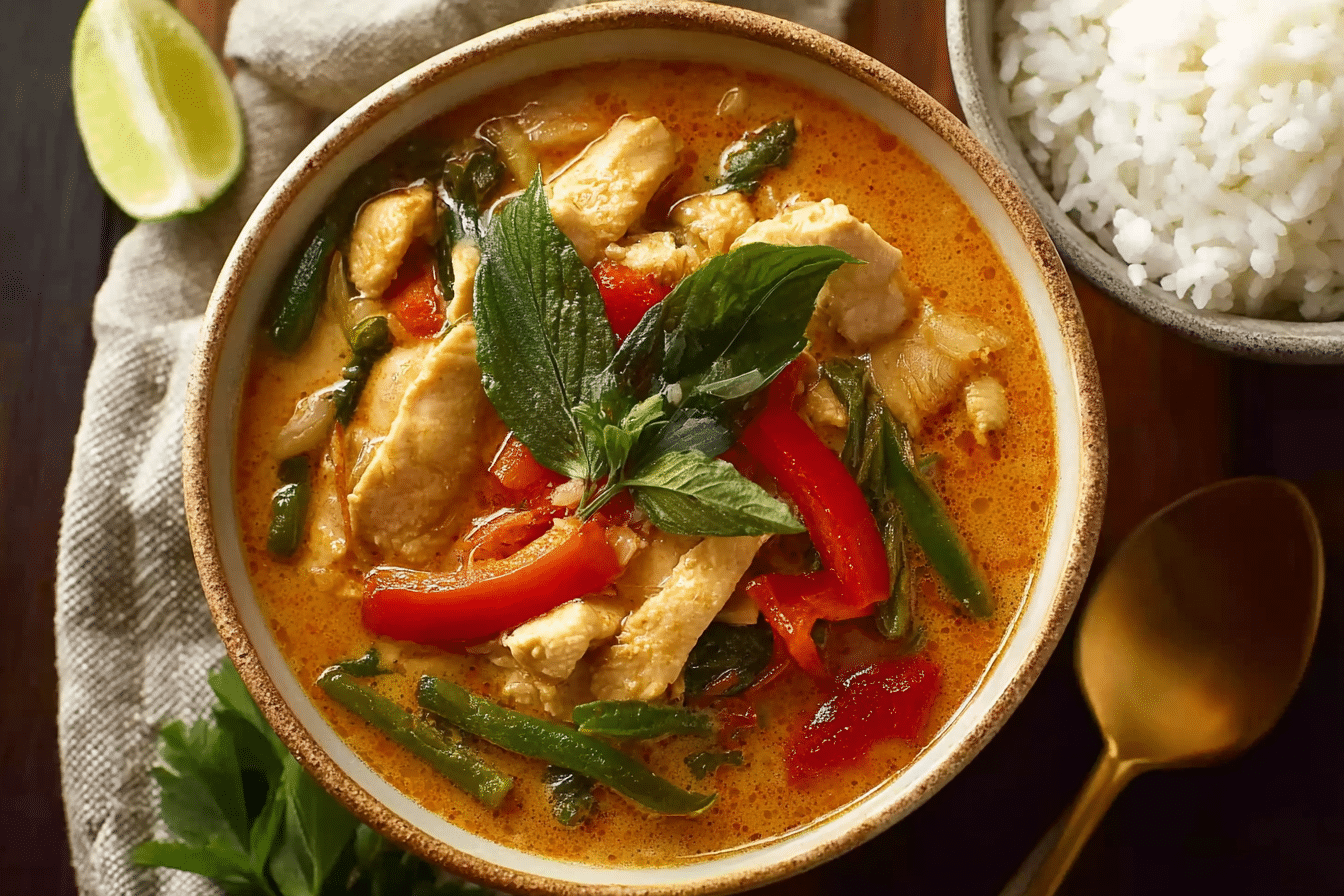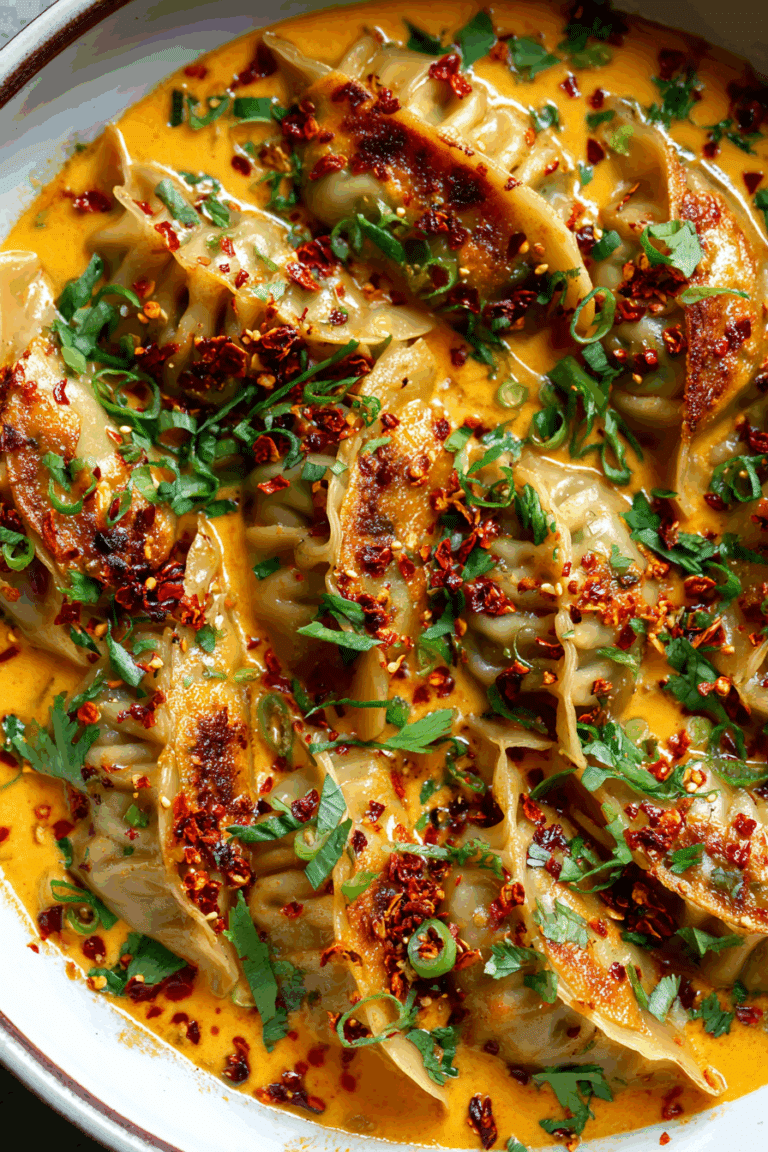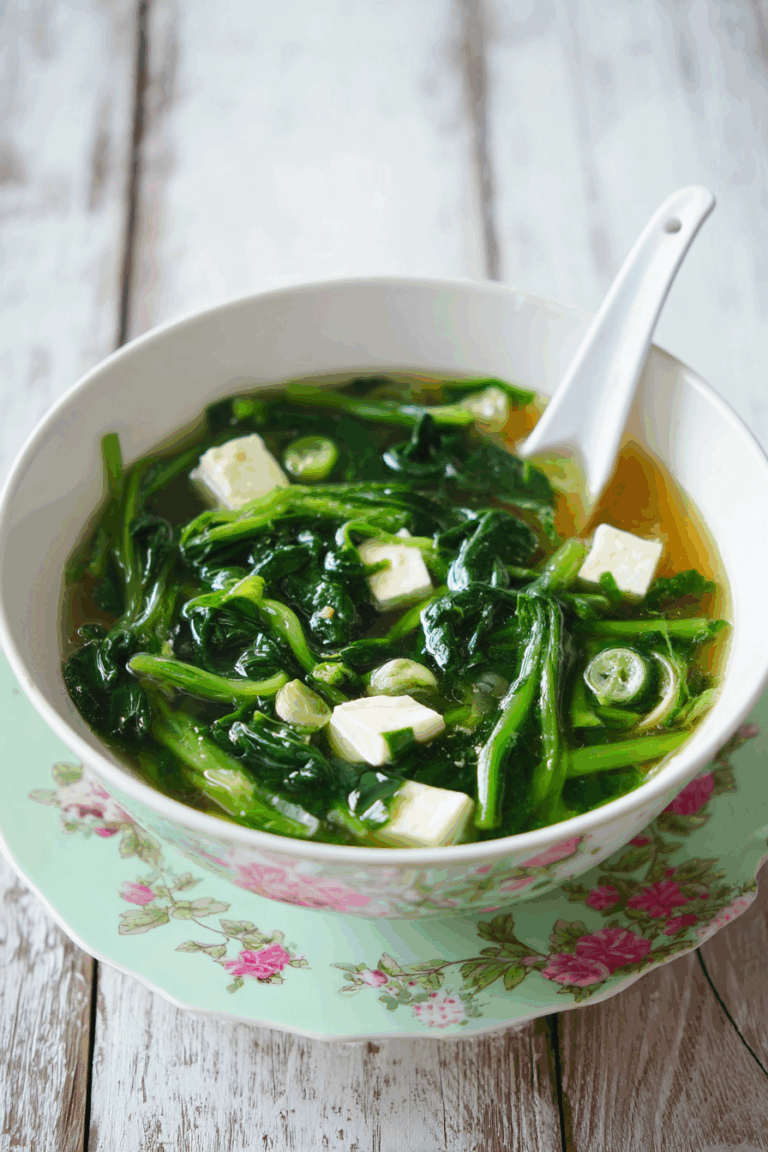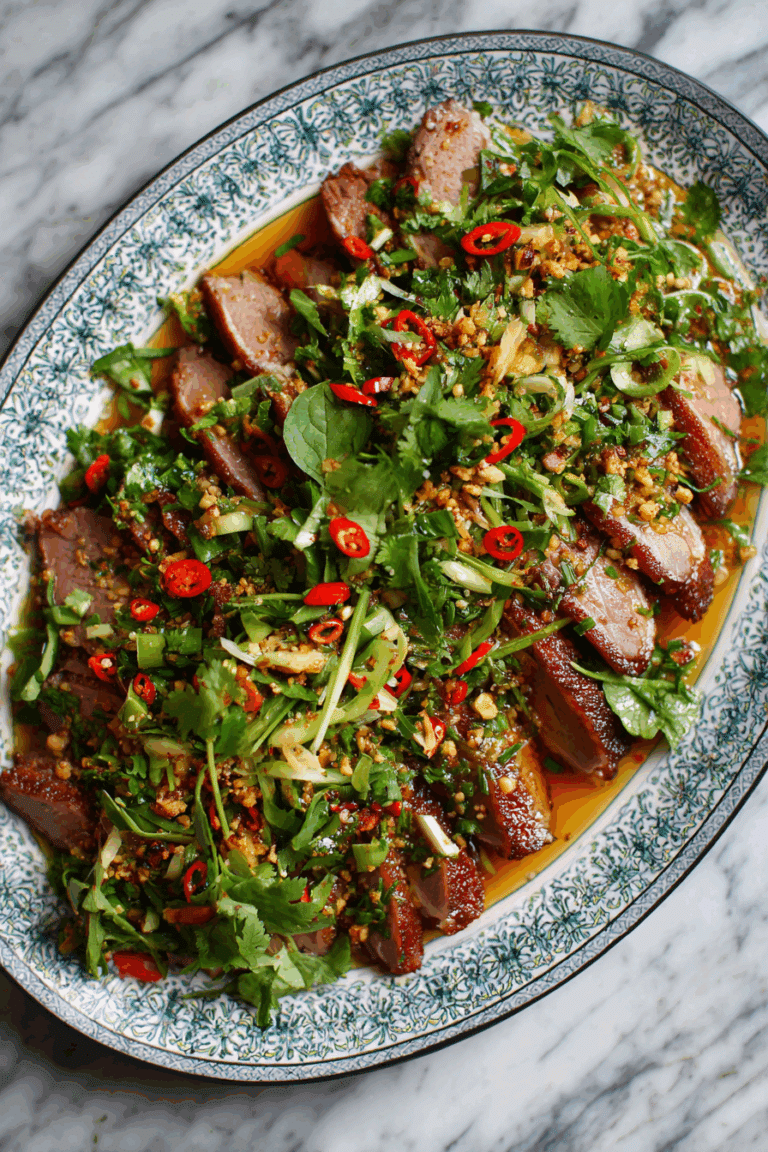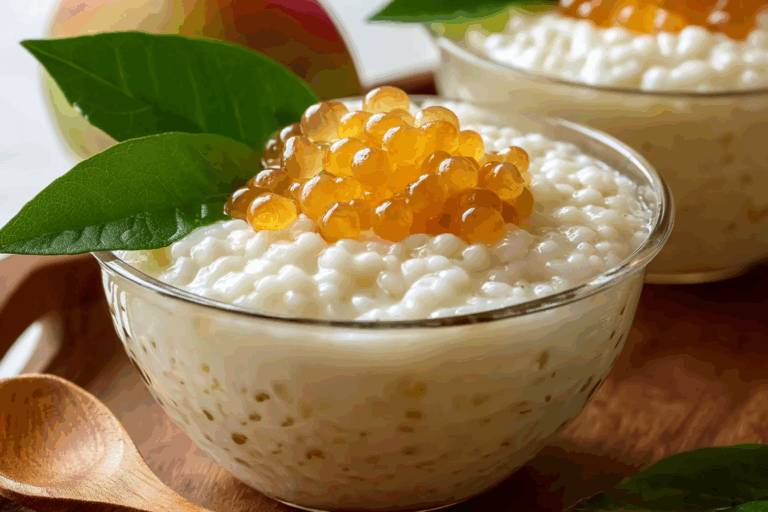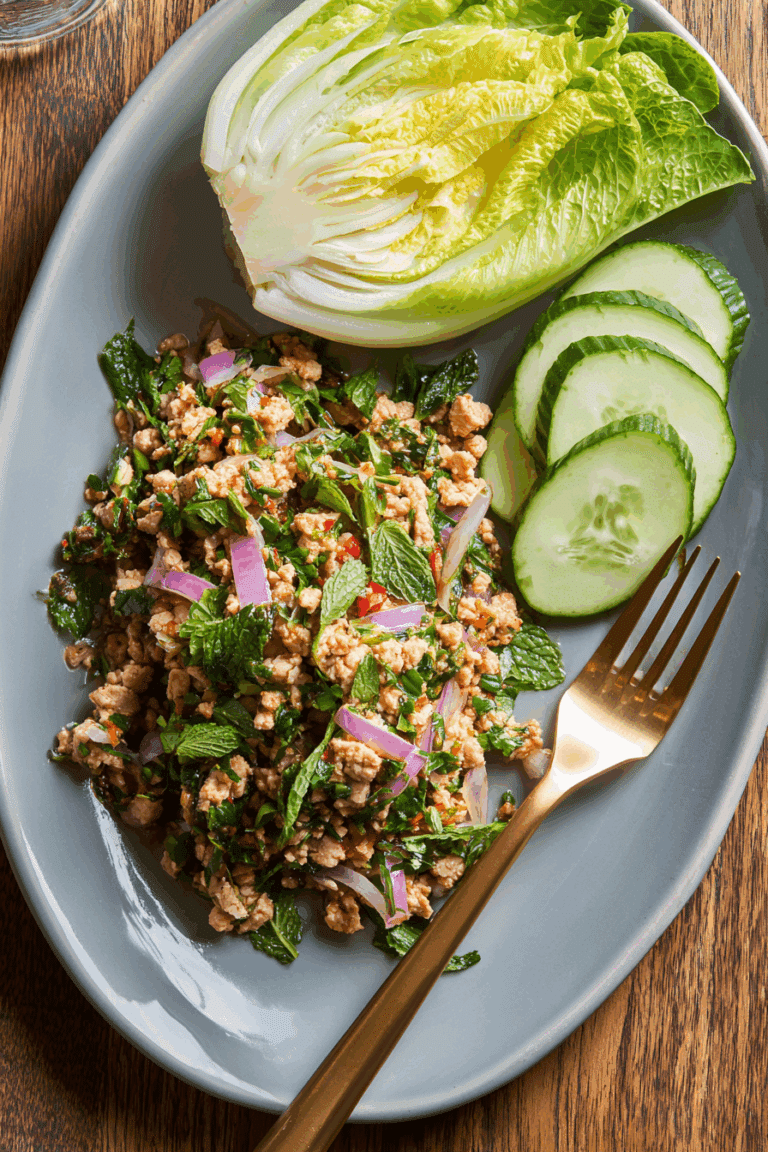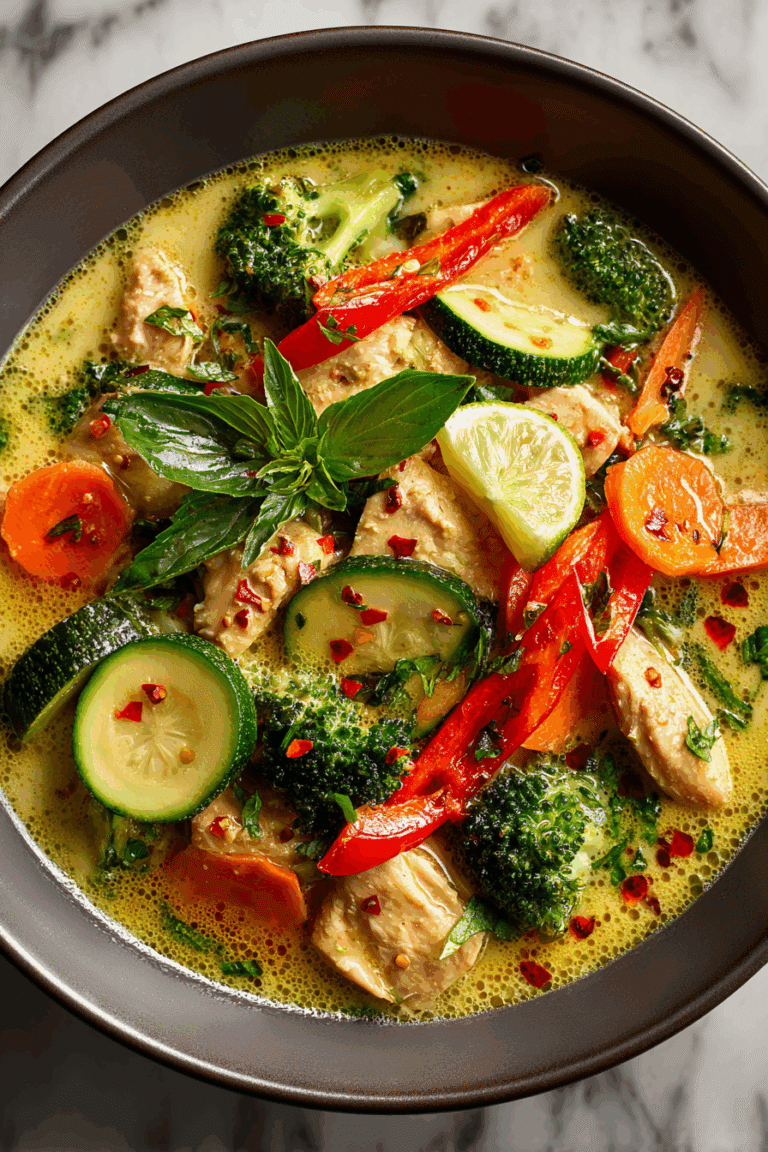Panang Curry: The Best Thai Curry Recipe for Flavor Lovers
Panang Curry has been one of those recipes that stayed with me from the very first time I tasted it. It was during my travels in Thailand, wandering through night markets filled with sizzling woks and the irresistible aroma of fresh herbs and spices. The dish I discovered was nothing short of magic.
That memory is also part of the reason I started Just Thai Recipes. On the About Page, I shared how Thai cuisine became more than a passion for me. It turned into a way to connect with others, to share stories through flavors, and to bring traditional Thai dishes to kitchens far beyond Asia.
When you taste Panang Curry, you are greeted with layers of flavor. It is creamy from coconut milk, nutty from peanut butter, fragrant from fresh basil, slightly sweet from sugar, and full of gentle heat from curry paste. Unlike fiery Thai red curry, Panang Curry is known for its balance. It is not just spicy, it is complex and rich, making it one of the most delicious Thai curries for both newcomers and longtime fans of Thai food.
In this detailed guide, we will go through everything you need to know about Panang Curry, from the ingredients you will need, to the step-by-step cooking process, to cultural history, tips for variations, and answers to the most common questions people ask. By the time you finish reading, you will be ready to cook an authentic Panang Curry at home and understand why it has captured the hearts of so many food lovers worldwide.
Table of Contents
Table of Contents
Ingredients
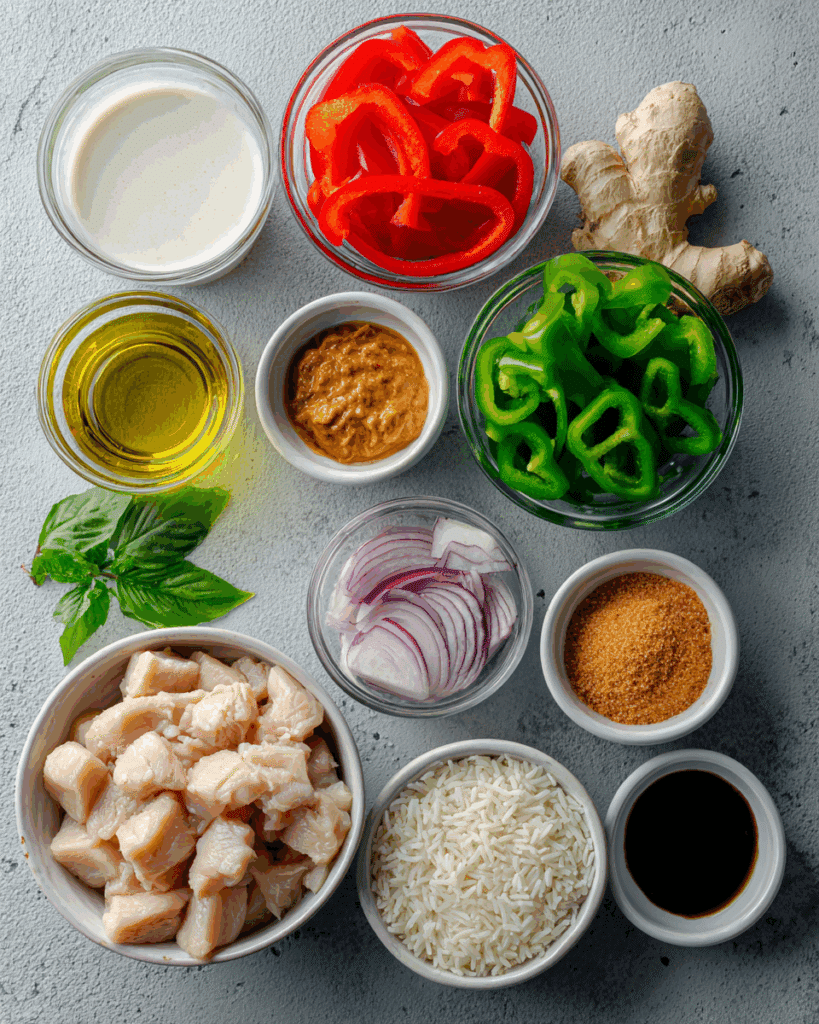
To make Panang Curry, you need a combination of pantry staples and fresh ingredients. Each one plays a role in building that creamy, nutty, aromatic profile that makes this dish so special. Below is the exact list used in this recipe:
- 1 tablespoon oil
- 2 tablespoons Panang curry paste * (you can use store-bought or try making your own at home)
- 1 tablespoon peanut butter
- 2 pounds chicken breasts, cut into pieces against the grain
- 1 small onion, sliced
- 1 green bell pepper, thinly sliced
- 1 red bell pepper, thinly sliced
- 2 teaspoons freshly grated ginger
- 4 garlic cloves, minced
- 2 cans coconut milk (14 oz each, Chaokoh brand works wonderfully)
- 2 teaspoons cornstarch
- 1/4 cup light brown sugar, packed
- 1 tablespoon fish sauce
- 1 tablespoon lime juice
- 1 cup loosely packed basil leaves, roughly chopped
- Hot cooked rice, white, brown, or jasmine
Ingredient Notes:
The type of protein you use can change the character of the curry. While chicken is classic, beef, shrimp, or even tofu are excellent choices. Panang Curry paste is the backbone of flavor, so pick a good quality one or make your own if you want a more authentic experience. Peanut butter may sound unusual to some, but it brings a nutty depth that defines Panang Curry. Coconut milk provides creaminess, and it is always better to choose full-fat coconut milk for a rich texture. Finally, basil and lime juice add freshness that balances the richness.
Step-by-Step Instructions
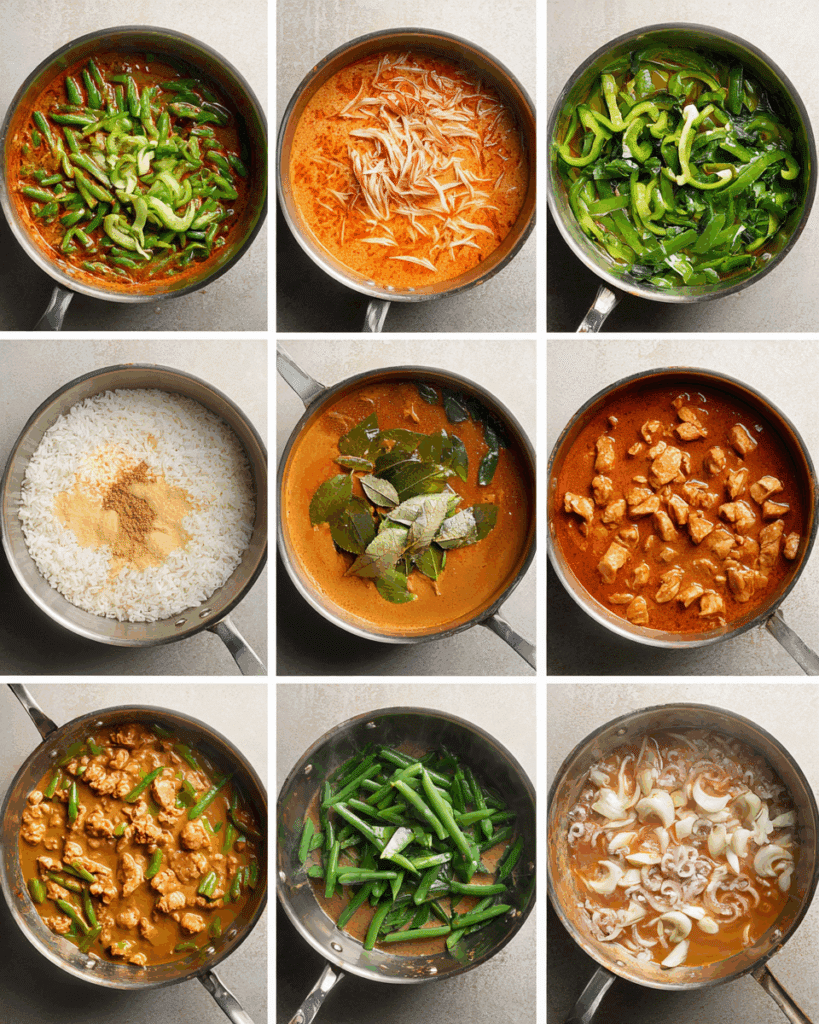
Making Panang Curry at home may sound intimidating, but once you see the process broken down, you will realize how simple and rewarding it is. This is a one-pan dish that comes together quickly, making it perfect for weeknight dinners or special occasions.
- Start by heating the oil in a large non-stick skillet over medium-high heat. Add the sliced onions and sauté for about two minutes. This will soften them and start building the aromatic base.
- Add the sliced bell peppers, garlic, and grated ginger. Cook for another two minutes, stirring occasionally so nothing burns. These vegetables and spices will infuse the oil with flavor.
- Stir in the Panang curry paste and peanut butter. Cook for one minute. This step is crucial because heating the curry paste releases its deep, complex flavors.
- Pour in one and a half cans of coconut milk. In a small bowl, whisk the cornstarch into the remaining half can of coconut milk, then add it to the skillet. Stir well to combine. This will thicken the curry base.
- Add the chicken pieces, stirring to coat them fully in the sauce. Reduce the heat slightly and let the curry simmer for 10 to 15 minutes, until the chicken is no longer pink and the sauce begins to thicken.
- Stir in the brown sugar, fish sauce, lime juice, and chopped basil. Simmer for another five minutes to allow all the flavors to come together. Taste and adjust with salt and pepper if needed.
- Serve hot over freshly cooked rice, whether white, brown, or jasmine, and enjoy your homemade Panang Curry.
For more inspiration on Panang Curry, including authentic cooking tips, you can check out Tastes Better From Scratch and Hot Thai Kitchen. Both resources dive deep into Thai cooking traditions and will help you explore this dish even further.
Tips and Tricks
When it comes to cooking Panang Curry, a few small tips can make a huge difference in flavor and texture. Always use full-fat coconut milk for creaminess. Do not rush the step where you cook the curry paste and peanut butter because this releases aromas that define the dish. If you like extra heat, you can add fresh Thai chilies when sautéing the vegetables. For a vegetarian version, replace chicken with tofu and use soy sauce instead of fish sauce.
One trick that many Thai cooks recommend is to add kaffir lime leaves toward the end of cooking. They are not always easy to find, but if you do, they will add a citrusy fragrance that makes the curry taste even more authentic. Another tip is to let the curry rest for 10 minutes before serving. The flavors meld together, and the curry tastes even richer. Finally, remember that Panang Curry is all about balance. Taste your curry and adjust the sugar, lime, and salt until you find the perfect harmony.
Variations
Panang Curry is incredibly versatile, and you can make it in many ways. Panang Curry beef is a favorite among meat lovers because the richness of beef pairs beautifully with the creamy sauce. Shrimp Panang Curry offers a lighter seafood twist and cooks quickly, making it great for busy nights. Panang Curry chicken is the classic version and is often what you find in Thai restaurants. For a unique touch, some regions prepare what is sometimes called Panang Curry Marion, which emphasizes the use of kaffir lime leaves for a stronger citrus aroma.
If you are vegetarian or vegan, Panang Curry can be adapted easily. Tofu or mixed vegetables like mushrooms, zucchini, and broccoli soak up the sauce beautifully. You can also experiment with different nuts. Some recipes add crushed peanuts instead of peanut butter, creating a slightly different texture. Each version highlights the flexibility of this dish while keeping the heart of Panang Curry intact.
Nutrition and Health Benefits
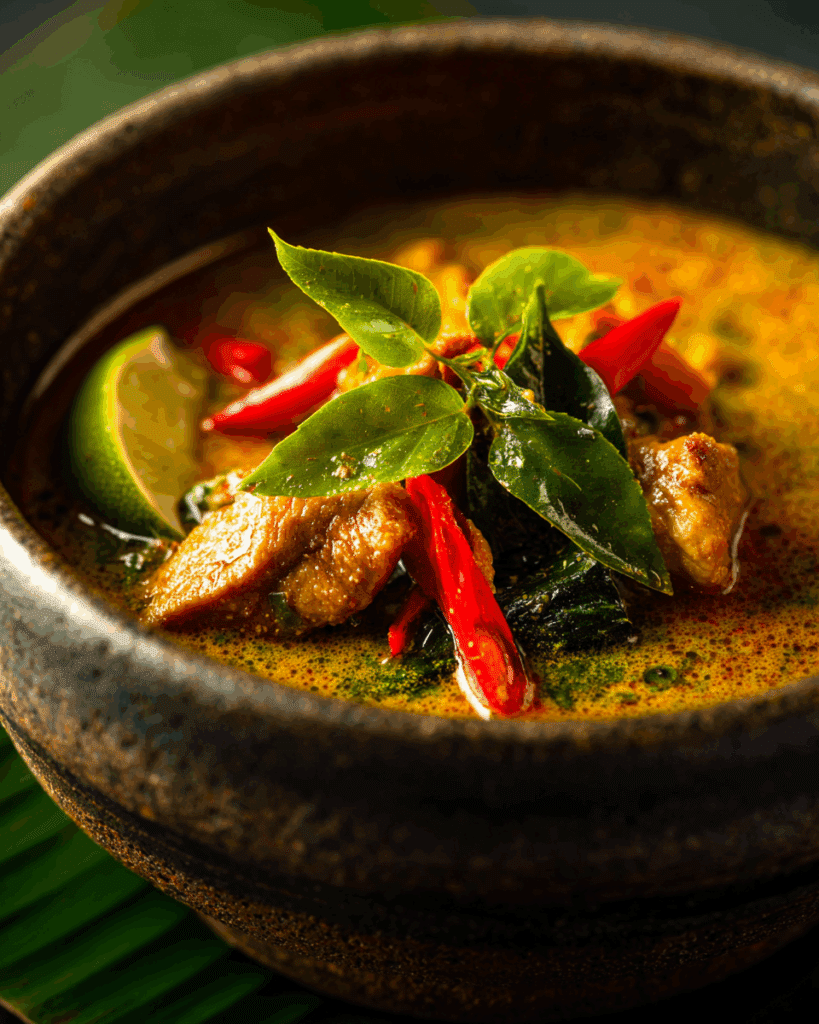
When you sit down with a bowl of Panang Curry, you are not only enjoying a dish that bursts with flavor but also one that carries surprising nutritional benefits. Panang Curry is often thought of as comfort food, something indulgent and rich, but if you take a closer look at the ingredients, you will see how much nourishment it brings to the table. Coconut milk, chicken, bell peppers, garlic, ginger, and basil all contribute to a meal that fuels your body while satisfying your taste buds.
A single serving of Panang Curry with chicken and rice can average around 450 to 550 calories, depending on portion size and the type of protein you use. The curry provides a solid balance of macronutrients, making it a hearty option for lunch or dinner. Chicken is packed with lean protein that supports muscle health and helps you feel full longer. Coconut milk, while higher in fat, contains medium-chain triglycerides, a type of fat that is easier to digest and can provide quick energy.
Another benefit of Panang Curry is the vitamins and minerals it delivers. The bell peppers are loaded with vitamin C, which supports your immune system and skin health. Garlic and ginger bring natural anti-inflammatory properties, which can help fight colds and support digestion. Basil leaves are rich in antioxidants and add a layer of freshness that is more than just flavor, it is wellness on a plate. Even the peanut butter in Panang Curry contributes protein and healthy fats, making the dish more balanced than many people realize.
If you make Panang Curry with beef, you add iron and zinc to your meal. Shrimp Panang Curry provides omega-3 fatty acids, which are excellent for brain health and heart health. A vegetarian Panang Curry with tofu gives you plant-based protein and fiber-rich vegetables, which aid digestion and overall energy. Each version of Panang Curry is versatile, allowing you to tailor the recipe to your personal health goals.
Eating Panang Curry in moderation fits well into many lifestyles. It is gluten-free if you use gluten-free soy sauce instead of fish sauce for vegetarian versions. It can also be adjusted for low-carb or keto diets by serving it without rice or with cauliflower rice. The key is balance. While the curry is creamy and flavorful, it does not have to be heavy or overly indulgent if you prepare it thoughtfully. That is one of the reasons Panang Curry is beloved, it feels indulgent while still providing genuine nutrition.
Make-Ahead, Storage, and Freezing
One of the best things about Panang Curry is how well it holds up as leftovers. Unlike many dishes that lose their magic after sitting in the fridge, Panang Curry becomes even better with time. The flavors of the curry paste, coconut milk, garlic, ginger, and basil deepen as they mingle together. This means that your second-day Panang Curry may taste even more satisfying than the first.
If you are planning to make Panang Curry ahead of time, you can prepare the curry paste base and chop your vegetables in advance. Store the chopped vegetables in airtight containers in the fridge and keep the curry paste mixture sealed separately. When you are ready to cook, everything will come together quickly. Some people even prefer to simmer the Panang Curry a day before serving, then let it rest overnight in the refrigerator. By the next day, the flavors are richer, and the sauce is creamier.
For storage, place leftover Panang Curry in airtight containers and refrigerate for up to four days. Always store it without rice if possible, because rice tends to soak up the sauce and become mushy. If you need to store both together, it is fine, but separating them keeps the texture better.
Freezing Panang Curry is also an option. Allow the curry to cool completely, then transfer it into freezer-safe containers. It can stay in the freezer for up to two months. When you are ready to reheat, let it thaw overnight in the fridge, then warm it gently on the stove. Avoid microwaving at high power because it can cause the coconut milk to separate. A slow reheat with a little splash of fresh coconut milk will bring your Panang Curry back to its original creamy texture.
This make-ahead and storage flexibility makes Panang Curry a fantastic dish for meal prep. You can double the recipe, freeze half, and have a homemade Thai meal ready for busy nights. Whether it is Panang Curry chicken, Panang Curry beef, or shrimp Panang Curry, the dish keeps beautifully and ensures you always have a delicious option waiting for you.
Common Mistakes to Avoid
Panang Curry may be simple to prepare, but there are a few mistakes that can affect the final flavor and texture. Understanding these common errors will help you make Panang Curry like a pro every single time.
The first mistake is overcooking the protein. Chicken breasts, in particular, can become dry if cooked too long. Since Panang Curry simmers in coconut milk, you want to cook the meat just until it is no longer pink. If you are making Panang Curry beef, slice the beef thinly and simmer only until tender. For shrimp Panang Curry, add the shrimp toward the end of cooking because shrimp cooks quickly and becomes rubbery if left in the sauce too long.
Another mistake is using low-fat coconut milk. Panang Curry depends on the creaminess of full-fat coconut milk. Reduced-fat versions make the curry watery and dull. If you are concerned about fat content, it is better to reduce your portion size than compromise on flavor by using a thin substitute.
Some cooks skip the fish sauce or peanut butter because they are unsure of the flavors. Leaving them out takes away the essence of Panang Curry. Fish sauce adds salty depth and umami, while peanut butter or ground peanuts provide the nutty richness that defines Panang Curry compared to red curry. Always include them, and adjust quantities to your taste.
Another issue arises when basil is added too early. Fresh basil should always be stirred in near the end of cooking. Adding it early causes it to wilt and lose its fragrance. Freshness is a key part of Panang Curry, and basil should always shine brightly in the dish.
Finally, the biggest mistake of all is not tasting and adjusting. Thai cooking is about balance. Panang Curry should be sweet, salty, creamy, nutty, and slightly tangy. Always taste before serving. If it is too salty, add a touch of sugar. If it is too sweet, add more lime juice or fish sauce. If it feels flat, a little more curry paste can bring it back to life. Cooking Panang Curry is not just about following steps, it is about using your senses to balance the flavors.
Cultural and Historical Background
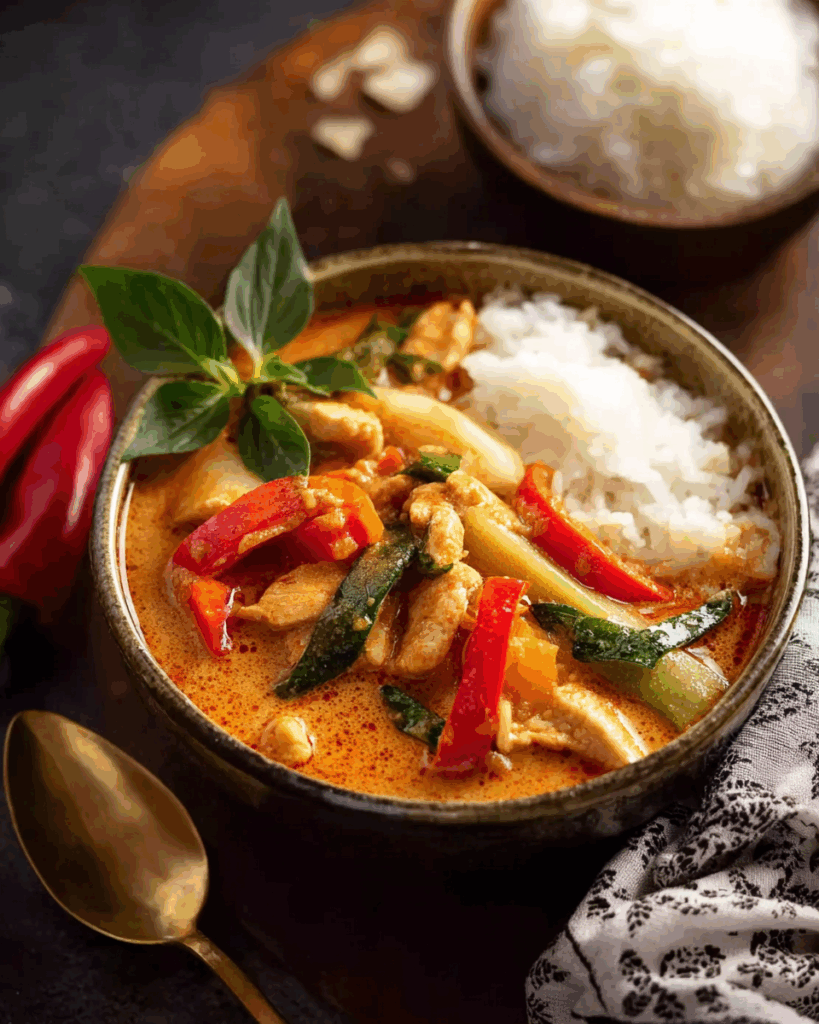
Panang Curry has roots in Thai culinary tradition, but it also carries influences from neighboring regions. It is believed to have originated in central Thailand but with connections to Laos and Malaysia. The name Panang, also spelled Phanaeng, is thought to come from a word in Malay that means crossed, which refers to the way meat was once prepared by cutting it across the grain.
In Thai cuisine, Panang Curry is unique compared to other curries. It is thicker, sweeter, and nuttier than red curry or green curry. Traditionally, Panang Curry was made with beef and flavored with ground peanuts and kaffir lime leaves. Over time, the dish evolved to include chicken, pork, and seafood, making it versatile for different tastes. The combination of coconut milk and peanuts gives Panang Curry a rich, almost stew-like quality that distinguishes it from lighter Thai curries.
Panang Curry is often enjoyed at family meals and festive gatherings. In Thailand, it is commonly served with jasmine rice, which balances the richness of the curry. The curry is not usually served extremely spicy. Instead, it is more mellow, making it popular even among those who are new to Thai flavors.
Beyond Thailand, Panang Curry has become one of the most recognized Thai curries in the world. Thai restaurants in the United States, Europe, and Australia often include Panang Curry on their menus because it is approachable, flavorful, and comforting. It represents the harmony of Thai cooking, where sweet, salty, sour, and spicy notes come together in balance.
For many, Panang Curry is more than just a dish. It is a bridge between cultures, a way to experience Thai flavors in a form that is both authentic and adaptable. Whether you enjoy Panang Curry chicken, beef, or shrimp, you are tasting a piece of Thai culinary history.
Serving Suggestions
One of the most beautiful things about Thai cuisine is that a single dish is never meant to stand completely alone. Instead, it often forms part of a larger spread, where textures and flavors play against each other in harmony. When you serve a creamy coconut-based curry at home, think of it not only as the centerpiece but also as part of a full meal experience.
Traditionally, this kind of dish is paired with freshly steamed jasmine rice. The rice is not just a filler. It balances out the richness of the sauce, so every bite feels complete. Some people prefer brown rice for a slightly nutty and healthier option, while others enjoy sticky rice for a more traditional texture. If you are looking for a low-carb variation, cauliflower rice works surprisingly well, soaking up the flavors while keeping the meal light.
Beyond rice, consider side dishes that bring contrast. A crisp green papaya salad offers a refreshing crunch and tang that cuts through the creaminess of the curry sauce. Fresh spring rolls with herbs and vegetables add lightness and texture, while fried spring rolls bring a satisfying crunch. A Thai-style cucumber salad dressed with lime juice, fish sauce, and chili flakes is another excellent companion, cooling the palate between bites.
For drinks, pairing matters more than most people realize. A cold Thai iced tea with its sweetness and creamy texture echoes the flavors of the curry but in a completely refreshing way. If you prefer something less sweet, a crisp lager or a light white wine like Riesling works wonderfully, balancing the richness of the dish. Sparkling water with lime is also an underrated pairing, keeping the flavors bright and cleansing the palate.
If you are hosting a dinner party, consider serving the curry as part of a multi-course Thai-inspired meal. Start with an appetizer like satay skewers with peanut sauce, followed by a light soup such as Tom Yum, and then present the curry with rice and a salad. Finish with a dessert like mango sticky rice or coconut ice cream, and you will have given your guests a full journey through Thai flavors.
At home, though, simplicity often wins. A big bowl of curry, a side of rice, and maybe some extra herbs on top are more than enough to make any meal feel comforting and special. Garnishing with extra basil leaves or a squeeze of lime before serving gives freshness to every spoonful. And if you enjoy a little heat, sliced fresh chilies on the side allow each person to spice it up to their own liking.
When readers explore recipes online, they often find themselves falling into a rabbit hole of related dishes, ingredients, and comparisons. That is part of what makes discovering new flavors so exciting. For Thai dishes, there are several common topics and variations that come up time and time again.
One of the most frequent comparisons is between this dish and red curry. While both share some similarities, they differ in intensity and balance. Red curry is usually spicier and more broth-like, while the coconut-based dish in focus here is thicker, richer, and slightly sweeter. Many home cooks want to know how to decide between the two, and the answer usually comes down to personal taste and spice tolerance.
Another popular search involves the paste itself. Many people wonder if they should buy premade curry paste from the store or try making their own at home. Store-bought versions are convenient and deliver solid flavor, but making it from scratch offers a fresher and more customizable result. Recipes for homemade paste often include lemongrass, galangal, dried chilies, kaffir lime zest, and ground peanuts, all blended into a vibrant, aromatic paste. This homemade approach allows you to control the spice level and ensures that every batch is as fresh as possible.
Beef and shrimp versions are also common search interests. The beef variation is hearty and comforting, offering a deeper, more savory flavor that stands up well to the richness of coconut milk. The shrimp variation, on the other hand, is lighter and cooks much faster, making it ideal for quick weeknight dinners. Each version carries its own unique appeal, and many people enjoy alternating between them depending on their mood and available ingredients.
There are also searches for ingredient lists and substitutions. People want to know if peanut butter can be replaced with crushed peanuts, if soy sauce can be used instead of fish sauce for vegetarians, or if lighter coconut milk can be used to cut calories. Each substitution changes the character of the dish slightly, but Thai cuisine is flexible, and adapting it to your lifestyle is always possible.
Finally, searches often lead people toward the cultural aspects of the dish. They want to know about its history, its role in Thai cuisine, and how it differs from curries in neighboring countries. This curiosity shows that food is never just about taste. It is also about context, culture, and the stories that travel with every bite.
Conclusion
Cooking Thai food at home is an experience that goes beyond following a recipe. It is about learning balance, embracing fresh ingredients, and allowing yourself to connect with another culture through flavors. This particular dish, with its creamy texture, nutty undertones, and fragrant herbs, has become one of the most beloved curries not only in Thailand but around the world. It strikes the perfect balance of being approachable for beginners while still complex enough to impress seasoned cooks.
If you have followed this recipe step by step, you now know how easy it is to bring restaurant-quality flavors into your kitchen. The combination of coconut milk, fresh vegetables, spices, and a touch of sweetness creates a meal that feels both comforting and exotic. Whether you make it with chicken, beef, shrimp, or tofu, the results are always satisfying.
What makes dishes like this so special is not only how they taste but also how they bring people together. Sharing a bowl of curry with rice at the dinner table has a way of making conversations flow more easily. The warmth of the spices, the creaminess of the sauce, and the brightness of herbs all come together in a way that feels welcoming and generous.
I encourage you to try this recipe and make it your own. Adjust the spice level, experiment with different proteins, and do not be afraid to taste and tweak as you go. Cooking is not about perfection, it is about enjoyment. When you sit down with your family or friends and share a meal you cooked yourself, you will understand why Thai food holds such a special place in so many hearts.
So go ahead, gather your ingredients, and prepare a dish that is rich in flavor, full of tradition, and guaranteed to leave everyone asking for seconds. And if you enjoyed this recipe, be sure to save it, share it, and come back to explore even more Thai favorites.
FAQ
Which is the tastiest Thai curry?
Taste is always subjective, but many people consider this dish the most satisfying because it offers richness without overwhelming heat, making it approachable for almost everyone.
What is it made of?
The core ingredients include curry paste, coconut milk, peanut butter or crushed peanuts, a protein such as chicken or beef, fish sauce, lime juice, basil, garlic, ginger, and fresh vegetables like bell peppers and onion.
What is the difference between red curry and this one?
Red curry is spicier and more liquid, while this version is thicker, sweeter, and has a nuttier undertone. The difference lies mostly in the use of peanuts and the texture of the sauce.
What does it taste like?
It is creamy, slightly sweet, nutty, and mildly spicy. The combination of coconut milk, peanut butter, fresh herbs, and spices creates a flavor that is both rich and balanced.
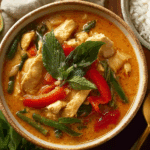
Panang Curry
- Prep Time: 15 minutes
- Cook Time: 25 minutes
- Total Time: 40 minutes
- Yield: 6 servings 1x
- Category: Main Course
- Method: Stovetop
- Cuisine: Thai
- Diet: Gluten Free
Description
A rich and creamy Thai Panang Curry made with chicken, coconut milk, peanut butter, and fresh herbs. This comforting curry is full of flavor and perfect to serve with jasmine rice for an authentic Thai meal at home.
Ingredients
- 1 tablespoon oil
- 2 tablespoons Panang curry paste *
- 1 tablespoon peanut butter
- 2 pounds chicken breasts, cut into pieces against the grain
- 1 small onion, sliced
- 1 green bell pepper, thinly sliced
- 1 red bell pepper, thinly sliced
- 2 teaspoons freshly grated ginger
- 4 garlic cloves, minced
- 2 (14 oz) cans coconut milk (Chaokoh brand recommended)
- 2 teaspoons cornstarch
- 1/4 cup light brown sugar, packed
- 1 tablespoon fish sauce
- 1 tablespoon lime juice
- 1 cup loosely packed basil leaves, roughly chopped
- Hot cooked rice, white, brown, or jasmine
Instructions
- Heat oil over medium-high heat in a large non-stick skillet. Add the sliced onion and sauté for 2 minutes.
- Add the bell peppers, garlic, and ginger. Sauté for another 2 minutes.
- Stir in the curry paste and peanut butter. Cook for 1 minute to release flavors.
- Add 1 ½ cans of coconut milk. In a small bowl, whisk cornstarch into the remaining ½ can coconut milk and add to the skillet. Stir well.
- Add chicken pieces, stirring to coat. Simmer for 10–15 minutes until chicken is no longer pink and sauce thickens.
- Stir in brown sugar, fish sauce, lime juice, and basil. Simmer for 5 minutes more.
- Season with salt and pepper to taste. Serve hot over cooked rice.
Notes
- Use full-fat coconut milk for the best creamy texture.
- For vegetarian options, substitute chicken with tofu and use soy sauce instead of fish sauce.
- Add kaffir lime leaves for extra fragrance if available.
- Shrimp or beef can be substituted for chicken depending on preference.
- This curry tastes even better the next day as the flavors deepen.
Nutrition
- Serving Size: 1 bowl with rice
- Calories: 480
- Sugar: 14g
- Sodium: 780mg
- Fat: 29g
- Saturated Fat: 19g
- Unsaturated Fat: 8g
- Trans Fat: 0g
- Carbohydrates: 28g
- Fiber: 3g
- Protein: 32g
- Cholesterol: 85mg
Keywords: Panang Curry, Thai curry, Panang curry paste, chicken curry, creamy Thai curry, peanut curry, coconut milk curry, Thai recipes

